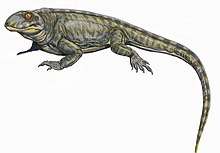Caseoides
Caseoides is an extinct genus of large pelycosaur synapsids that lived in the Kungurian Age (late Early Permian epoch). It was about 3 metres (9.8 ft) long, and like many other caseids, it was herbivorous and aquatic. It weighed between 150 to 200 kilograms (330 to 440 lb). Its fossils were found in San Angelo Formation, Texas.[1] Caseoides was very similar to Casea, but was slightly larger in size. Caseoides was a heavily built creature, as are most of the Caseids (except Caseopsis). In the development of its proportionally thick, stout limbs it represents the culmination of the Casea lineage. Its relatives became smaller in size during the Roadian Age. Only poorly preserved postcranial material is known including limbs. [2]
| Caseoides | |
|---|---|
| Scientific classification | |
| Kingdom: | Animalia |
| Phylum: | Chordata |
| Clade: | †Caseasauria |
| Family: | †Caseidae |
| Genus: | †Caseoides Olson and Berrbower, 1953 |
| Species: | †C. sanangelensis |
| Binomial name | |
| †Caseoides sanangelensis Olson and Berrbower, 1953 | |
References
- Olson, Everett C.; Berrbower, James R. (1953). "The San Angelo Formation, Permian of Texas, and Its Vertebrates". The Journal of Geology. 61 (5).
- Ronchi, Ausonio; Sacchi, Eva; Romano, Marco; Nicosia, Umberto (2011). "A Huge Caseid Pelycosaur from North-Western Sardinia and Its Bearing on European Permian Stratigraphy and Palaeobiogeography". Acta Palaeontologica Polonica,. 56 (4): 723–738.CS1 maint: extra punctuation (link)
See also
- List of pelycosaurs
- Caseopsis - a relative of Caseoides, they lived side-by-side in Texas, but Caseopsis was lightly built, unlike Caseoides
- Casea - another relative, only smaller in size, but Casoides and Casea were very similar in body shape
This article is issued from Wikipedia. The text is licensed under Creative Commons - Attribution - Sharealike. Additional terms may apply for the media files.
